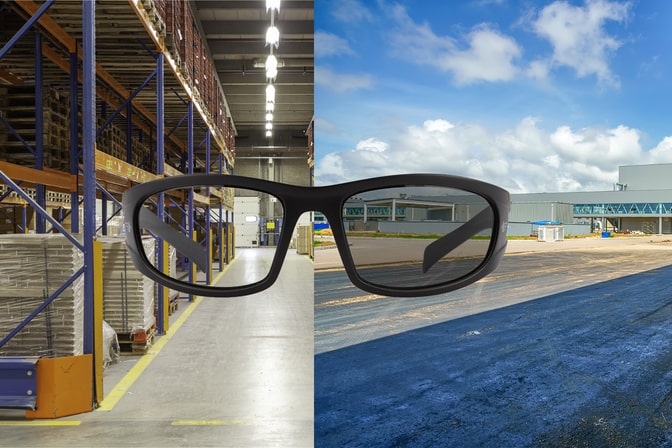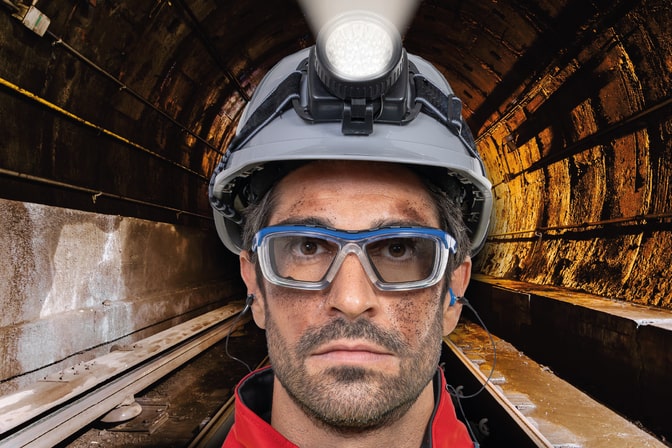In the workplace, ocular safety is an undisputed priority. With technology constantly evolving, photochromic lenses have become a popular choice for those seeking effective and versatile eye protection. In this article, we will explore different types of photochromic lenses, their underlying technologies, and the physical, chemical, and mechanical properties of the materials used in their manufacturing.
Types of Photochromic Lenses
Silver Halide-Based Photochromic Lenses
These lenses incorporate silver halides in their composition. When exposed to ultraviolet light, these halides undergo a molecular structure change, causing the lenses to darken. This process is reversible, meaning the lenses will return to clear when UV exposure is removed.Polymer-Based Photochromic Lenses
Polymer-based photochromic lenses contain organic photosensitive molecules that react to UV light. When these molecules absorb UV rays, they trigger a molecular structure change in the polymer, darkening the lenses. Similar to silver halide-based lenses, the process is reversible.Operation of Photochromic Lenses:
The basic principle behind photochromic lenses is the ability of lens materials to change their structure in response to UV light exposure. Under normal light conditions, the lenses remain clear. However, when exposed to UV rays, photosensitive molecules undergo a change that results in lens darkening.
Technologies Used
Microcrystal Technology
Some photochromic lenses utilize microcrystals for darkening. When activated by UV light, these crystals disperse within the lens, causing it to darken. This technology provides quick and efficient changes in lens shade.Photochromic Polymer Technology
Photochromic polymers, such as spirooxazine molecules, are crucial in these lenses. These polymers undergo conformational changes when exposed to UV light, leading to lens darkening.Materials Used and Their Properties
High-Performance Plastics
Photochromic lenses are often made from high-performance plastics like polycarbonate. These materials offer impact resistance, lightweight properties, and clear optics.Anti-Scratch and Anti-Reflective Treatments
Many manufacturers apply additional coatings to lenses to enhance durability, such as scratch-resistant and anti-reflective coatings. These treatments ensure longevity and clear vision in demanding work environments. In conclusion, photochromic lenses not only provide essential eye protection in the workplace but also offer comfort by automatically adapting to changing light conditions. The choice between different lens types and underlying technologies depends on the specific needs of each user and the workplace environment. By investing in high-quality photochromic lenses, clear vision and effective eye protection are ensured during all work tasks.Benefits of Using Photochromic Lenses in the Workplace:
Adaptability to Changing Conditions:
Photochromic lenses are renowned for their ability to automatically adjust to light conditions. In workplaces where lighting can vary significantly, these lenses ensure clear and comfortable vision at all times—from bright outdoor sunlight to indoor artificial lighting.Continuous UV Protection:
UV exposure is a constant concern, even in workplaces. Photochromic lenses provide continuous UV protection by darkening in the presence of UV radiation. This not only shields eyes from short-term issues like eye strain but also helps prevent long-term problems such as cataracts and macular degeneration.All-Day Comfort:
Workers spend long hours in their environments, making visual comfort crucial for maintaining focus and productivity. With photochromic lenses, there's no need to switch between sunglasses and clear glasses constantly. The seamless transition between clarity and darkening allows users to concentrate on their tasks uninterrupted.Style and Aesthetics:
As technology advances, photochromic lenses have become stylish and appealing. Workers not only gain functional benefits but also have the option to choose modern, attractive styles that fit their personal preferences. This can increase acceptance and consistent use of protective eyewear.
When Are Photochromic Lenses the Best Choice for Eye Protection?
Outdoor Work:
For those involved in outdoor activities such as construction, agriculture, or field inspections, photochromic lenses are ideal. They automatically adjust to intense sunlight, providing clear vision and protecting eyes from UV damage.Changing Office Environments:
In offices with sun-exposed windows, photochromic lenses are an excellent choice. They allow workers to seamlessly move between areas with natural light and indoor spaces, ensuring optimal vision at all times.Industries with Frequent Lighting Changes:
In industrial environments where lighting can change rapidly due to moving machinery or production process changes, photochromic lenses offer constant protection without requiring manual adjustments.Mobile and Multitasking Workers:
Professionals who constantly move between indoors and outdoors or perform tasks requiring constant visual attention greatly benefit from photochromic lenses. They eliminate the need to change glasses and allow seamless transitions between different work environments.
